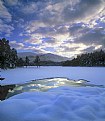It's possible to get a multiple exposure as you describe, somehow masking half of the film while exposing the other half, and then repeating, but it probably won't work well with a card held in front of the lens. The dividing line created by the card will probably be somewhat visible, although very out of focus. This technique might work if you make sure the subject matter you are shooting does not extend to the center of the frame, but is very dark at the center of the frame. Does that make any sense? Maybe not.
Anyway, lots of large format photographers have made multiple exposures by masking the film, but this is done behind the lens, in the actual film holder itself, only a few millimeters away from the film--the dark slide itself is cut and serves as the mask. It is possible to create a very distinct dividing line this way, because the mask is not in front of the lens, it's almost against the film. You might need to see a large format sheet film holder to understand this one. Suffice it to say that this is difficult or impossible with a 35mm SLR camera, because you can't easily mask at the film plane. Well, I suppose you could, but you'd have to do it in a darkroom, and then take the camera back into the darkroom to....NAH, you couldn't really do it. I'm sure someone will say they have, now that I've said that.
I've wondered too about the forest shot with 50 exposures. One way to do this would be to cut a piece of film off of a roll and tape it to the pressure plate inside the camera. You could fire off shots, allowing the advance mechanism to wind, but the film would not move. I would imagine the shutter would be quite fast and the aperture quite tiny, and possibly a ND filter used as well. Anyway, I don't remember technical info included with that shot.
I'd start with some standard multiple exposures--two shots layered onto each other on one frame. Take the first frame. Hold in the film release button on the bottom of the camera as you wind the film, preventing it from advancing. Take the second shot, and then advance the film normally. You can get some surprising results doing this, and it's often very unpredictable. Try shooting a roll that way and see what happens.
|
















